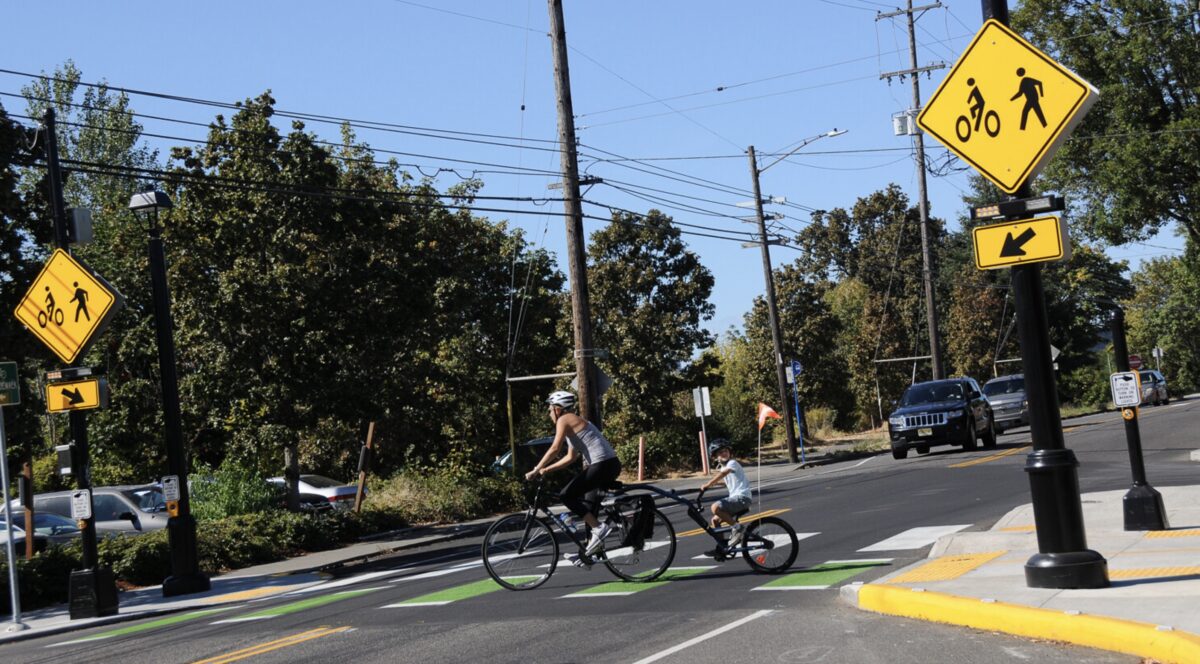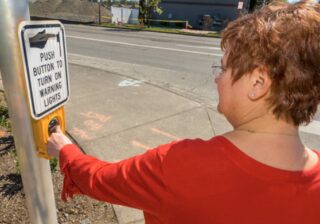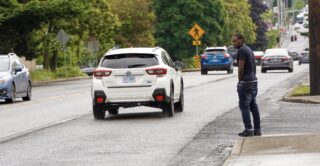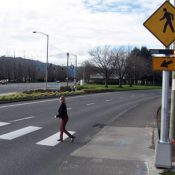
(Photo: Jonathan Maus/BikePortland)
Do you like those flashing beacon crossings? You know, the ones where you hit the beg button and lights flash and people (are supposed to) stop for you to cross? If so, you’ll be happy to hear that the Oregon Department of Transportation has announced many more on are on the way. “The beacons are a critical part of ODOT’s efforts to maintain a modern and safe transportation system,” read an ODOT statement last Thursday.
ODOT says the beacons are “an effective tool for improving safety on busy corridors, especially in areas with long distances between traffic signals” and that they, “provide an additional layer of safety and assurance for anyone crossing a busy road.” The agency also emphasized the value of these crossings for sight-impaired people.
Of the 25 additional flashing beacons ODOT says they’ll install in the next two years, ten of them will be on Southeast Powell Boulevard (Highway 26).
Advertisement

This is the type of investment Metro Council Juan Carlos Gonzalez has said he wants ODOT to do more of — instead of funding more freeway lanes. “There’s urgency in communities like those I represent in Washington County to drastically improve pedestrian safety,” Gonzalez said in the ODOT statement.
Here are the Portland area locations where ODOT is either under construction on new crossings or has them queued up between now and 2023:

82nd Avenue at NE Pacific and SE Mitchell Streets
OR 99E at SE Boardman and SE Hull Avenue
NE Sandy Boulevard at NE 108th Avenue
*NE 82nd Avenue at NE Alberta
North Lombard at N. Delaware and N. Emerald
SE Powell Boulevard at SE 108th, SE 116th, SE 119th, SE 140th, SE 145th, SE 151st, SE 156th, between SE 157th and SE 160th, SE 166th and 168th
SE 82nd Avenue at SE Cooper Street, SE Clatsop Street
This doubling-down on beacons comes as no surprise, as this type of infrastructure has proven very popular with politicians and policymakers alike for years. At around $100,000 per crossing, they’re much cheaper than overhead “HAWK” beacons (like at E Burnside and 41st, which run about $400,000 a piece) or full-fledged signals (which can start at $800,000), and since they’re less intrusive to motoring they don’t tend to be very controversial.
Beyond their relatively low cost, these beacons give road agencies a relatively easy way to respond to community pressure after a fatal collision.
Since they were first used by ODOT in 2009, they’ve often been installed at locations after people have been hit and killed trying to cross the street. That was the case with Angela Burke on SW Barbur, and the tragic collision on SE Foster that killed Jennifer Leonard and her friend Jessica Finlay in 2010. *It continues with the forthcoming beacon on NE 82nd and Alberta, where Stephen Looser and Anthony Tolliver were killed back in April.
In their announcement about the new beacons, ODOT emphasized a companion educational effort on how to use them. However, Oregon law is already clear that if a person intends to cross a street at an intersection (marked or not), vehicle users are required to “stop and stay stopped” until they cross. While these enhanced crossing tools are helpful, they wouldn’t be needed if people traveled at a safe speed and with the requisite amount of attention and care on their task.
While a welcome sight for many, these beacons also represent yet another hoop we have to jump through to mitigate the harms inherent in our dangerous, driving-dominated streets and the dysfunctional traffic culture that perpetuates it.
CORRECTION: This story originally had outdated cost estimates for flashing beacons, HAWK, and full signals. The price listed now is 2-3 times higher than originally reported. I regret any confusion.
— Jonathan Maus: (503) 706-8804, @jonathan_maus on Twitter and jonathan@bikeportland.org
— Get our headlines delivered to your inbox.
— Support this independent community media outlet with a one-time contribution or monthly subscription.






Thanks for reading.
BikePortland has served this community with independent community journalism since 2005. We rely on subscriptions from readers like you to survive. Your financial support is vital in keeping this valuable resource alive and well.
Please subscribe today to strengthen and expand our work.
I really like flashing beacons! Instant gratification when you press that command button!
Watts and others seem to really like the beacons because they are quick. But while an actual red light may be a few seconds slower, it’s a lot safer. On N Lombard at both intersections with N Delaware and N Drummond, there are currently buttons on both sides of Lombard that causes the light to turn red (go try it, it works great). Now it will just be a beacon?!?
So this is what we get for our $16.5M? This seems like just an effort to improve “travel-time predictability” aka make it faster for drivers. This is typical ODOT and it bothers me that they hid this behind the label of “Activated Pedestrian Signal” like it was an upgrade.
Right now when he hits the button and the light turns red on Lombard, my 2 year old can run safely across once we give him the go-ahead. No way I’d do that with just a beacon. It’s a safety downgrade.
The signal at Tacoma and SE 19th is like you describe and is absolutely terrible. Between the flashing yellow, flashing red and solid red, drivers don’t know what to do (not surprising). It is unfortunately far better to go to the plain crosswalk at SE 21st and cross there, it has good line of sight and although at the bottom of a hill from both sides, people are generally quick to stop. I also use the signal at SE 18th and Bybee, and it is a flashing beg button, and works really well.
That’s not a rapid flash beacon, it’s a pedestrian hybrid beacon.
Need one desperately at 36th ave SE & Powell.
With this intersection as well as others I think I’d prefer actual stoplights like Hawthorne and 29th. My opinion is that flashing lights are completely reasonable on roads with 3 or less lanes, but on roads with 4 or more stop lights are necessary.
Powell is not great for crossing opportunities, and it gets worse as you go east. There’s another crosswalk with no lights at 75th. The exit from the shopping center at 82nd and Powell could use a light at 80th to facilitate people trying to turn left as they leave the parking lot to go east on Powell.
As a cyclist, pedestrian and driver I really like flashing beacons. They remind motorists and cyclists to look out for pedestrians, and give pedestrians a little more visibility.
The more of these installed the better.
I love these things. The vast, vast majority of times drivers fail to stop for people crossings in crosswalks isn’t malice; it’s sheer ignorance. These remove that ignorance by providing a clear signal that someone is trying to cross. Sure, compliance isn’t 100% and a HAWK beacon would be better, but I feel much safer crossing at these locations than at other marked crosswalks and they’re certainly worth the money.
I like them even better than HAWKs because they are so responsive.
I love using the flashing beacons — the response from people driving is almost always immediate. I’d rather have one of those than a full signal installed, which are going to take much longer to get approved, require more waiting time in my experience, and cost a ton more. The city’s HAWK signals are OK to me, too.
It’s a half measure. Why not a real red light? It carries no legal weight.
The crosswalk alone carries legal weight but I agree that there should be far, far greater legal weight for a failure to yield at a rapid flash beacon.
Why a beacon > full signal for me: I cross at a rapid flash beacon much more quickly than a signal. And I don’t feel that safety is compromised. Plus the cost is attractive. Context is critical, though — I realize they don’t work as well on wider roadways.
These are ok and way better than nothing but on a 5 lane (2 lanes each direction plus turn lane in the middle) street like on SE Stark and 133rd, the road is too wide for only flashing lights at the sidewalk, this crossing used to have a beacon on the middle island but it never lasted more than a week or two from being mowed over by cars, cost a fortune, I believe called out here and now doesn’t get replaced. Drivers rarely stop for this crossing until 1 of 3 or 4 stop and I force the issue by proceeding before all lanes are stopped. The beacons are to far aside in the field of vision and not big or bright enough in daylight, especially when sunny.
Like I said, better than nothing and glad they are going to add more but they need to be bigger, brighter and more visible front and center of the road so drivers have no excuse for not seeing it when they are not paying good attention or just plain trying to ignore it.
They just added a big overhead on on 82nd just downhill from Madison HS. Massive cantilevered arm that (hopefully) no one mows down. Now the rest in the area keep getting taken out. The one on NE Glisan at 78th has been missing for months.
WHY CAN’T THE BEACONS BE BETTER PROTECTED?
The median refuges need to be protected with steel bollards. Both to protect pedestrians and cause damage to anyone who hits it.
ODOT should name each crossing after the people who needlessly died at that spot while they spent time building freeways.
e.g. the 82nd and Alberta beacon could be named “The Stephen Looser and Anthony Tolliver Memorial Crossing” with a big sign.
Traffic deaths need to stop being normalized by the likes of ODOT. Maybe all the crossing should have little plaques too, “Vision Zero Died Here”
I’ve always thought that dying is not such a great accomplishment that things should be named after people who die. This includes cops and such. Just sayin.
Doesn’t outer Powell already have most of its RFBs already installed? I know many were installed even before I left town in 2015. The one at Sandy and 108th was installed in 2012 or so; is this a replacement?
The $50,000 RFB treatment also includes the pedestrian island, markings, etc. – each of the beacons is only $2,000 retail.
For a legal mid-block red-amber-green hanging lights with a beg-button at each end and marked pedestrian crossing but no extra concrete island costs about $16,000 for a street with one lane in each direction and about $25,000 for a stroad with two lanes in each direction, at least here in North Carolina, plus a traffic study.
The $200,000 treatment is for a 3-way or 4-way full intersection, with deluxe metal poles, markings, etc.
It would be even better if there were some occasional enforcement. Seeing a cop pulling someone over would send motorists a message that “you really do have to stop for pedestrians in a crosswalk.”
Like painting gutters and calling them bike lanes, or slapping plastic straws on those gutters and calling them “protected,” these are certainly better than nothing. But they’re half measures, if that, and still prioritize auto traffic over human lives.
Life isn’t like Burger King, or a Rolling Stones song, which means you can’t always have it your way, and you can’t always get what you want. I think that plenty of resources are already devoted to bicycle safety, and I’m grateful for what we have. The car is king, and to think that bicycle safety will always be elevated over the needs and wishes of motorists is to deny politial reality.
The”king” is due for being deposed.
Decapitated, more like.
Always elevated about the wants of motorists? Unlikely. I’d like to see public transit and pedestrian and bicycle infrastructure elevated over the wants of motorist even 10% of the time. I’d right now we are at about 1%.
The only infra that PBOT and ODOT reliably build is infrastructure that in no way inconveniences motorists or slows them down.
I mean PBOT literally has a hierarchy of transportation that has cars at the bottom. Not unreasonable for citizens to actually hold them to their supposed values.
All of these signals need to timeout faster. They are left blinking far too long and lead to drivers ignoring the flashing lights.
I believe the signal length is timed for visually impaired people, seniors, and other vulnerable roadway users who do not scurry or run across the road in deference to people driving cars.
I really wish they had two button modes; short & long, kind of like the #1 or #2 buttons on a toilet. I feel like I am diminishing the effectiveness when I push the button, run across, and then a bunch of drivers are left fuming for the “eternity” of another 10 seconds.
When the crosswalk is clear, drivers can legally proceed, even if the lights are still flashing. I see drivers do this routinely. No need to wait.
I’ve also noticed that some will get “stuck on” from time to time. It really confuses people.
Concerns list:
1. The people most in need are the least likely to push. Button pushing rates as I recall are around 30 to 50%.
2. You don’t fix cancer by putting band aids on it. The beacons do nothing to change the deadly physics (high speed, high volume) and deadly configurations (multiple, wide lanes with long straightaways) that trigger* these installations and that remain as an unaddressed hazard at all of the remaining crossings on the corridor (which will typically be a high crash corridor for all modes). *Google NCHRP 562 for info, and check out the spreadsheet that spits out crossing treatments based on various operating choices: https://www.oregon.gov/odot/Planning/Documents/NCHRP562.xls
3. The more of these we put in the more drivers will expect them every place people are crossing. A massive investment to do these throughout a corridor would be cost prohibitive and diminish their effect. These are amping our streets up when we need to be ramping down.
4. People always ask for these. They look impressive and feel good to use because on a per-push basis they get more drivers to stop. The months or years of advocacy (or cumulative injuries/deaths) required to get one takes the focus off the underlying problems: traffic speed and volume, lane count and widths, long uncalmed straightaways.
5. Even looking at one crossing in isolation the data that these save lives only holds up when you compare them to an alternative choice of doing nothing.
6. It looks like Oslo (same population as Portland) got from similar crash numbers as Portland to zero ped deaths and zero bike deaths… without a single RFB. Someone can tell me if that’s wrong.
“The more of these we put in the more drivers will expect them every place people are crossing.”
That’s a great point. It’s similar to the “TURNING VEHICLES YIELD TO PEDESTRIANS CROSSING” signs I’m seeing more frequently at places where lots of cars are turning. It’s nice to see them, but on the other hand it gives the impression you don’t have to yield if the intersection doesn’t have one. With prevalent flashers, many drivers will think, “If that guy wants me to stop so he can cross, he should cross at the signal (flasher) only two blocks away”, similar to people not stopping downtown for pedestrians crossing at a non-signaled crossing.
One could make the same argument for marked enhanced crosswalks, PHB signals, or, even, conventional signals. I prefer RFBs (~47% reduction in ped crashes) to PHBs (69% reduction) based on the fact that we can install 3-5x as many of them for the same cost.
Is traffic homicide a crisis or not?
https://safety.fhwa.dot.gov/ped_bike/step/docs/TechSheet_RRFB_508compliant.pdf
If we can get the PPB and OSP to stop fighting automated traffic enforcement, it’d be great to rig these things with cameras and issue tickets to any motorist who fail to stop. Hard to argue you didn’t see the flashing lights.
I only know what I know. As a pedestrian and cyclist, I’ve seen first hand how crossing with a flashing beacon really grabs motorists’ attention. As a driver, flashing beacons certainly get my attention. Of course you need to remain vigilent while crossing. I don’t see the need for more protection except maybe at the very worst intersections.
I certainly see the need for more protection. We need more protection because “every corner is a crosswalk” is not enough and marked crosswalks without beacons aren’t enough for many drivers to stop. Perhaps I’m biased because I walk everywhere and have had countless experiences of drivers either not paying attention or making eye contact and driving right by, sometimes going 10 or more MPH over the limit.
In more egalitarian wealthy nations RFB-like infrastructure is typically paired with physical infrastructure (e.g. speed bumps, raised crosswalks, or other barriers to speeding).
Reading this immediately after the Metro Council IBR article amuses me. By ODOT logic, these beacons will increase GHG emissions because cars will stop more. They should just eliminate all the crosswalks to stop global warming!
Really surprised that MLK Boulevard in NE isn’t getting a few of these. There are some marked crossings that could really benefit from flashing beacons. Is MLK not maintained by ODOT?
Nope, that section MLK (south of Columbia) is maintained by PBOT. And it’s typical PBOT incompetence to do everything but the common-sense solution.
Confused about the proposed Delaware/Lombard beacon. That’s already an actuated signal with a full phase for Delaware crossing Lombard. This shouldn’t be ‘downgraded’ to an RRFB, especially since PBOT has eyed Delaware as an upcoming neighborhood greenway